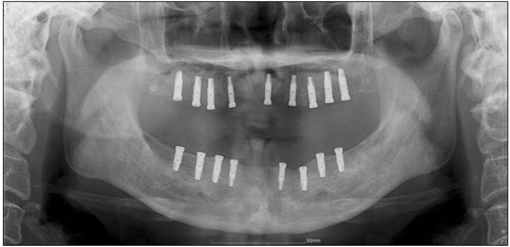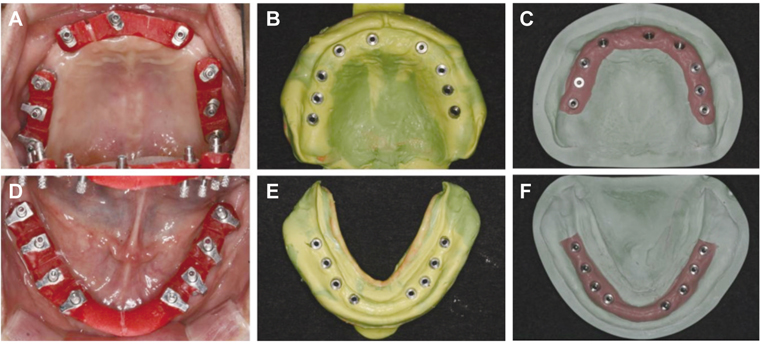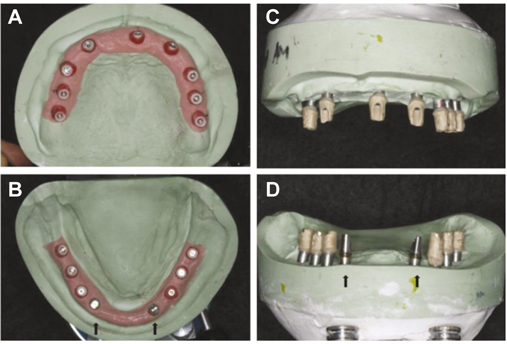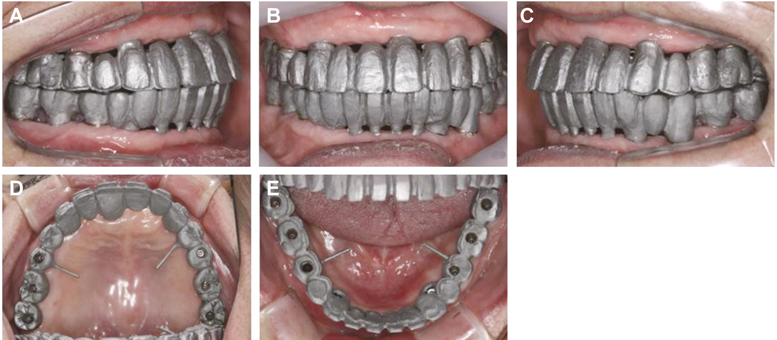J Korean Acad Prosthodont.
2012 Oct;50(4):318-323. 10.4047/jkap.2012.50.4.318.
Retrievable SCP (screw-cement prosthesis) implant-supported fixed partial dentures in a fully edentulous patient: a case report
- Affiliations
-
- 1Department of Prosthodontics, School of Dentistry, Pusan National University, Yangsan, Korea. cmjeong@pusan.ac.kr
- KMID: 2195475
- DOI: http://doi.org/10.4047/jkap.2012.50.4.318
Abstract
- Implant prostheses were classified into screw-retained prosthesis and cement-retained prosthesis by their method of retaining, and there is screw and cement retained implant prosthesis (SCRP) which has been made reflecting the strengths of these two. The advantages of the SCRP technique are easy retrievability and passive fit of implant prostheses. However, the occlusal screw holes of implant prostheses can be thought as a disadvantage with respect to esthetics and occlusion. Inappropriately positioned implants also limited the use of the SCRP technique. The present study is reporting about the case where nine implants (US II, OSSTEM, Seoul, Korea) were placed in maxilla and eight in mandible respectively in fully edentulous patients. Then, the cement-retained prosthesis was applied for the part in which the screw hole positioned improperly, and screw-retained prosthesis for properly positioned implants so that the combined screw-cement prosthesis has been produced where the satisfying result has shown in both function and esthetics. Three-year follow-up has been done for the patient.
MeSH Terms
Figure
Cited by 1 articles
-
The effect of heat to remove cement on implant titanium abutment and screw
Hyo-Gyoung Yi, Ki-Sung Gil, Jung-Jin Lee, Seung-Geun Ahn, Jae-Min Seo
J Korean Acad Prosthodont. 2018;56(3):179-187. doi: 10.4047/jkap.2018.56.3.179.
Reference
-
1. Misch CE. Screw-retained versus cement-retained implant-supported prostheses. Pract Periodontics Aesthet Dent. 1995. 7(9):15–18.2. Chee W, Felton DA, Johnson PF, Sullivan DY. Cemented versus screw-retained implant prostheses: which is better? Int J Oral Maxillofac Implants. 1999. 14:137–141.3. Misch CE. Contemporary implant dentistry. 1999. 2nd ed. St. Louis: Mosby Inc.;549–593.4. Hebel KS, Gajjar RC. Cement-retained versus screw-retained implant restorations: achieving optimal occlusion and esthetics in implant dentistry. J Prosthet Dent. 1997. 77:28–35.
Article5. Michalakis KX, Hirayama H, Garefis PD. Cement retained versus screw-retained implant restorations: a critical review. Int J Oral Maxillofac Implants. 2003. 18:719–728.6. Taylor TD. Prosthodontic problems and limitations associated with osseointegration. J Prosthet Dent. 1998. 79:74–78.
Article7. Zarb GA, Schmitt A. The longitudinal clinical effectiveness of osseointegrated dental implants: the Toronto study. Part III: Problems and complications encountered. J Prosthet Dent. 1990. 64:185–194.
Article8. Breeding LC, Dixon DL, Bogacki MT, Tietge JD. Use of luting agents with an implant system: Part I. J Prosthet Dent. 1992. 68:737–741.
Article9. Goodacre CJ, Kan JY, Rungcharassaeng K. Clinical complications of osseointegrated implants. J Prosthet Dent. 1999. 81:537–552.
Article10. Pauletto N, Lahiffe BJ, Walton JN. Complications associated with excess cement around crowns on osseointegrated implants: a clinical report. Int J Oral Maxillofac Implants. 1999. 14:865–868.11. Aparicio C. A new method for achieving passive fit of an interim restoration supported by Brånemark implants: a technical note. Int J Oral Maxillofac Implants. 1995. 10:614–618.12. Preiskel HW, Tsolka P. The DIA anatomic abutment system and telescopic prostheses: A clinical report. Int J Oral Maxillofac Implants. 1997. 12:628–633.13. Voitik AJ. The Kulzer abutment luting; Kal technique. A direct assembly framework method for osseointegrated implant prostheses. Implant Soc. 1991. 2:11–14.14. Rangert B, Jemt T, Jörneus L. Forces and moments on Branemark implants. Int J Oral Maxillofac Implants. 1989. 4:241–247.15. Kan JY, Rungcharassaeng K, Bohsali K, Goodacre CJ, Lang BR. Clinical methods for evaluating implant framework fit. J Prosthet Dent. 1999. 81:7–13.
Article16. Kallus T, Bessing C. Loose gold screws frequently occur in full-arch fixed prostheses supported by osseointegrated implants after 5 years. Int J Oral Maxillofac Implants. 1994. 9:169–178.17. Kim SG, Park JU, Jeong JH, Bae C, Bae TS, Chee W. In vitro evaluation of reverse torque value of abutment screw and marginal opening in a screw- and cement-retained implant fixed partial denture design. Int J Oral Maxillofac Implants. 2009. 24:1061–1067.18. Lindström H, Preiskel H. The implant-supported telescopic prosthesis: a biomechanical analysis. Int J Oral Maxillofac Implants. 2001. 16:34–42.
- Full Text Links
- Actions
-
Cited
- CITED
-
- Close
- Share
- Similar articles
-
- Full mouth rehabilitation of edentulous patient with fixed implant prosthesis
- Implant Surgery for Fixed Implant-supported Prostheses in the Edentulous Mandible: A Case Report
- Effect of cement washout on loosening of abutment screws and vice versa in screw- and cement- retained implant-supported dental prosthesis
- Implant-assisted removable partial denture using freely removable abutment in a fully edentulous patient: A case report
- A Digitally Designed All-on-4 Restoration with Screwmentable Concept









